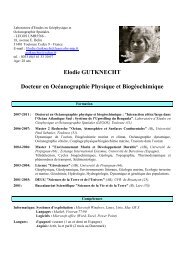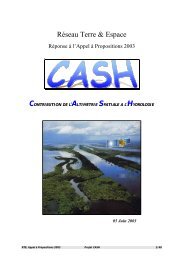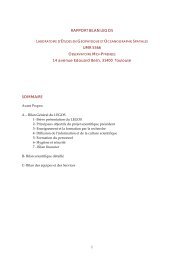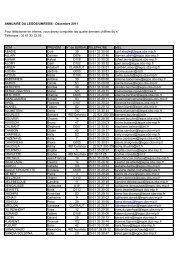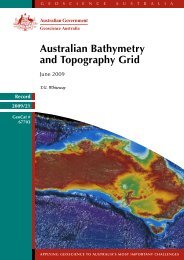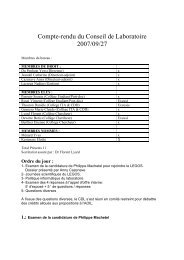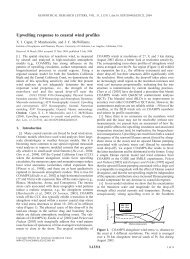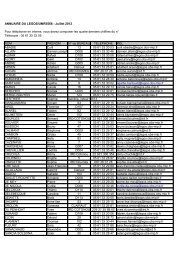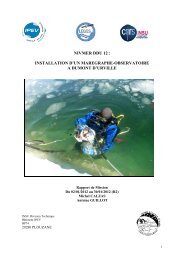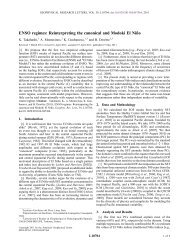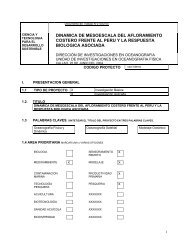UNIVERSITE TOULOUSE III - PAUL SABATIER Ecole ... - LEGOS
UNIVERSITE TOULOUSE III - PAUL SABATIER Ecole ... - LEGOS
UNIVERSITE TOULOUSE III - PAUL SABATIER Ecole ... - LEGOS
Create successful ePaper yourself
Turn your PDF publications into a flip-book with our unique Google optimized e-Paper software.
)¡ ¡ £¢$ ¡¢£ ¡ "$ £ £¢¤¢¡<br />
The Nd IC of a rock depends both on its age and samarium to neodymium ratio. ε Nd<br />
ranges from –40 in old continental formations (e.g.: Greenland; Taylor et al., 1992) to +10 in<br />
new volcanic formations (e.g.: Iceland; O'nions and Grönvold, 1973). The Nd found in the<br />
ocean is of terrigeneous origin. It is brought to the ocean in dissolved or particulate phases, by<br />
rivers, the atmosphere or remobilization from margin sediments. Within the ocean, most of<br />
the Nd is found in the dissolved phase, the particulate phase represents only 5 to 10% of the<br />
total content (Jeandel et al., 1995). Although input processes are still not completely<br />
understood, it seems that dissolved/particulate exchanges at the margins play a preponderant<br />
role (Jeandel et al., 1998; Lacan and Jeandel, 2001; Tachikawa et al., 2002). In the vicinity of<br />
lithogenic sources, ε Nd is thus used as a tracer of particle transport and dissolved particulate<br />
exchanges (Grousset et al., 1988; Jeandel et al., 1995; Tachikawa et al., 1999b). Away from<br />
them, it is conservative and used as a tracer of water masses (Piepgras and Wasserburg, 1987;<br />
Piepgras and Jacobsen, 1988; Jeandel, 1993; Jeandel et al., 1998; Lacan and Jeandel, 2001).<br />
Nd residence time in the ocean is around 500 to 1000 years (Tachikawa et al., 1999a). That<br />
makes ε Nd suitable to trace intra and inter ocean currents.<br />
ε Nd is widely used in paleo-oceanography. Signal variations stored in sediments (mostly<br />
metalliferous), are classically interpreted as reflecting past variations in circulation. Recently,<br />
several studies have suggested that fluctuations in the Nd sources, via variations in erosion<br />
rates, could also affect ε Nd records (Vance and Burton, 1999; Frank et al., 2001; Tachikawa et<br />
al., 2002).<br />
The past Nd IC of the North Atlantic Deep Water (NADW) has been particularly well<br />
studied (Burton et al., 1997; Abouchami et al., 1999; Vance and Burton, 1999; Rutberg et al.,<br />
2000). The production of this water mass initiates the conveyor belt circulation, and thus is a<br />
key factor controlling our climate (Broecker, 1991). NADW is formed out of four sources:<br />
Denmark Strait Overflow Water (DSOW), Island Scotland Overflow Water (ISOW),<br />
Labrador Sea Water (LSW) and Lower Deep Water (LDW, derived from Antarctic Bottom<br />
Water, AABW). Those are formed by convection in high latitudes: the DSOW and the ISOW<br />
in the Nordic Seas (Greenland, Island and Norwegian Seas), the LSW in the Labrador Sea and<br />
the AABW around the Antarctic continent (Dickson and Brown, 1994). The few data<br />
available before this work show that the Nd ICs of these sources are very distinct: ε Nd ≈ -8 in<br />
the Nordic Seas overflow waters, ε Nd ≈ -14.7 in the LSW and ε Nd ≈ -11.7 in the AABW<br />
(Piepgras and Wasserburg, 1987). ε Nd variations in the past or present NADW could thus be<br />
used to evaluate the relative contribution of each of its source waters and to draw conclusions<br />
about fluctuations in the conveyor belt activity, if it can be ascertained that the end-member<br />
values are constant.<br />
To further develop this potential application of ε Nd , we need to better understand how<br />
these waters acquire their signature. So far, only three Nd IC measurements were available for<br />
the Nordic Seas, which is insufficient to constrain the signature of the DSOW and ISOW. One<br />
of the goals of the Signature/GINS cruise (IFRTP) was to further address these questions. The<br />
cruise has been carried out on board the R/V Marion Dufresne, in July and August 1999, in<br />
the North Atlantic and more particularly in the Greenland and Iceland Seas. Hydrological<br />
parameters (θ, S, O 2 and Acoustic Doppler Currents) and chemical tracers: CFC, SF6, 129 I,<br />
REE and Nd IC have been measured. In this paper, we present Nd ICs and REE<br />
concentrations of seawater samples from the East Greenland Current (EGC), along the east<br />
Greenland slope, between the Fram and Denmark straits. We use these results to explain the<br />
ε Nd signature of the DSOW and to better constrain the circulation in the Denmark Strait.<br />
2



